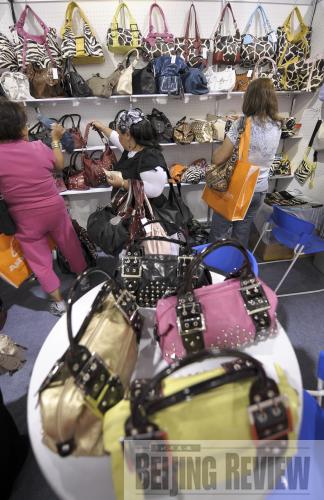|
 |
|
THE "IT" BAG: Shoppers choose from a selection of bags imported from China at the China Brand Show in Las Vegas (QI HENG) |
Nandhini Sundaram, a 20-year-old who works at a New York advertising firm, rarely looks at the label of origin sewn into the dresses or shoes she tries on.
"It does not matter to me where the product is made," she said.
William D'Eletto, President of the New York Association for American-Russian Relations, feels the same way.
"When I go shopping and I find something that I like, if it looks good and feels like it is good quality then I do not care where it's made," he told Beijing Review.
The reason he does not concern himself when shopping for home kitchen appliances, sportswear, souvenirs or gifts is because he knows most bear a label that says they are "made in China." When asked to name a few categories of products that are usually made in China, he said half jokingly, "It would be easier to name products that are not made in China."
Last year, the United States imported $388 billion of Chinese goods, a significant increase from about $81 billion in 1999.
Capelli New York is among the vast number of U.S. importers bringing in products from China. Founded in 1990 and based in New York City, Capelli targets juniors and contemporary markets throughout the United States. Its product lines include fashion accessories, hosiery, footwear, rainwear, sleepwear, home fashion and novelty gifts.
Most of the products that Capelli supplies for large retailers and boutiques are imported from other countries like China, South Korea and India, said Grace Sun, a Capelli New York employee.
"Over 90 percent of the imports are from China," Sun said.
The company has been importing apparel and accessories from China since 1989. Products Capelli buys from China, like handbags, hair accessories, hats, scarves, socks and shoes are very competitive in price, she said.
Sun also told Beijing Review that Chinese manufacturers are doing well making products based on design specifications.
Usually Capelli works out its own product designs and sends them to Chinese manufacturers with which the company works. The factory then produces a few samples based on the design, from which Capelli picks the one its buyers like most and places a production order. Once production is complete, products are shipped to the United States and distributed to department stores, retailers and boutiques.
"We do have quality issues," Sun said. "But the good thing is, generally speaking, the quality of 'made-in-China' products is not bad, and it has been improving."
The company has witnessed pretty good sales results in the U.S. market, except for the abnormal period around the financial crisis last year, said Sun.
Can consumers have high quality along with low price? Of course people want a good product for a good price. But most, like D'Eletto, know that "you always get what you pay for."
"If I shop at Macy's and find a shirt that I like and it's made in China, I know that it's good quality if Macy's is selling it. If I go to Lord & Taylor's and see nice shoes that I like and they are made in China, I know that they are going to be high quality," he said. "Now if I go to a 99-cent store and buy toys for my grandson that are cheap, I know that they will not be the same quality as Toys"R"Us."
The image of Chinese goods in the United States was tainted by the flood of low-end plastic accessories, fake handbags, home necessities and souvenirs that cost only a few dollars or less and are sold by street vendors, thrift stores and Chinatowns throughout the country.
"I try to avoid some products that are made in China, for example, some bicycle parts, because they do not appear to be as well-made," said Oliver Smith, a Portland, Oregon college student. But he said that it seems there has been an improvement in bicycling gear and other Chinese products over the past few years.
"I sometimes look at a well-made computer or a piece of furniture and see that it is from China," Smith said. "I expect to see more innovative, high-quality goods from China."
(Reporting from New York) | 